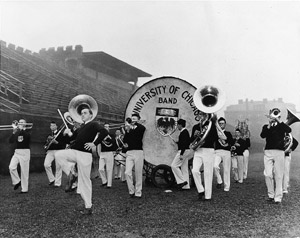 From
our pages
From
our pages
1912
- At the June 11 dedication of the William Rainey Harper Memorial Library, Alumni
Club president Donald Randall Richberg, AB 1901, proclaimed, "We, the alumni,
have become the University, and in this library we have been permitted to aid
in raising a monument both to President Harper and to that which he created in
us as the spirit of the University. Here is not only a memorial to one who has
gone from us, but also a mighty tablet whereon may read the message which he gave
to us and which we would reverently preserve." The building's keys were then
presented to President Harry Judson, who told the gathering that the library's
completion marked one of the University's most important construction eras and
that the Board of Trustees hoped to begin other "imperatively needed"
construction, including a new women's gymnasium, replacing the "very inadequate
and wholly unaesthetic" Lexington Hall. "Our women deserve better, and
the time has now come when the existing situation must be ended."

The
U of C Band marches with Big Bertha.
1952
- The Committee on Mathematical Biology, established in the late 1930s to explain
biological problems with mathematical formulas, began to study the phenomenon
of mass human behavior. Researchers constructed a mathematical description that
accurately predicted how fast a rumor spreads through a given population. They
found a similar formula that calculated whether a fashion would catch on and if
so, where and how fast. Also predictable was whether novelty alone was enough
to sell an item or if extra advertising was required. The spread of a fad or rumor,
they concluded, resembles the breakout of an epidemic: all are determined by the
ratio between the number of individuals who have succumbed and the number not
yet affected.
1977
- Cheryl Newman, PhB'45, BLS'48, AM'52, wrote to the Magazine about a fashion
trend she noticed on a summer trip to Europe: American college T-shirts were everywhere,
although not quite the way they looked back home. While Newman spotted many inaccurate
and mass-produced shirts, including a navy Princeton shirt with a red university
seal and a shirt for "Southern California University," she stumbled
upon authentic but antique Chicago garb for sale. "We were strolling along
one of the malls in Amsterdam, when I spotted…what was indubitably a University
of Chicago varsity sweater," Newman wrote. "Although it had been cleaned
and immaculately pressed, it was apparent from its appearance and style that it
dated from the 1930s." The sweater was shown with a matching maroon turtleneck
and cost around $35 U.S. Newman wished she had rescued the shirt, noting, "The
end of the story will forever be a mystery-I wonder how it got there."
1992
- An unprecedented number of alumni attended the Centennial Reunion held on a
summery June weekend. Also returning to campus was the world's largest drum, Big
Bertha (on loan from the University of Texas, which acquired the drum after its
years as the pride of Chicago's marching band). Freshly painted with the centennial
logo, Big Bertha was rolled out for the morning's events. Alumni gathered by Botany
Pond for the All-Alumni Cavalcade of Classes, a mingling that was soon interrupted
by the Alumni Association's Bagpipe Band, marching in formation through Cobb Gate.
It grew rainy and cold by evening, but some 300 alumni, staff, and students attended
a dance in the tent on the main Quad, twirling to a 15-piece swing band to keep
warm. The weekend was full of events and pleasant surprises. One alumnus, upon
visiting the Max Palevsky cinema, asked, "Max Palevsky gave this? [He] and
I used to shovel snow at the University together for 50 cents an hour!"-A.W.

![]()
 From
our pages
From
our pages